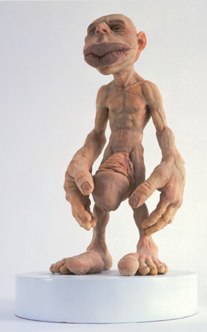This week, Weird Thing Culture Reporter Matt Finley takes a look at the Homunculus, a strange idea that survived against reason and logic. Monday we looked at how long the idea has been around. Wednesday we found out how science got past the idea of little naked men ruling our lives.
 The homunculi set a daring course – out of the genitals and into the brain. But before turning things over to all the scholarly yak yak of those incorrigible philosophers, I want to make a brief pit stop over in science. Remember that awesome part in “Blade Runner,” when Roy Batty is shaking down the replicant eye maker and says, “If only you could see what I’ve seen with your eyes.”? Well, before humans had any real understanding of how vision functioned, some people believed that there was a little brain-dwelling homunculus whose job it was to see what we see through our eyes, and then relate the information to our brains, so that the images weren’t lost, like, in the words of Batty, “tears in the rain.” (Seriously, though, how awesome is “Blade Runner”?)
The homunculi set a daring course – out of the genitals and into the brain. But before turning things over to all the scholarly yak yak of those incorrigible philosophers, I want to make a brief pit stop over in science. Remember that awesome part in “Blade Runner,” when Roy Batty is shaking down the replicant eye maker and says, “If only you could see what I’ve seen with your eyes.”? Well, before humans had any real understanding of how vision functioned, some people believed that there was a little brain-dwelling homunculus whose job it was to see what we see through our eyes, and then relate the information to our brains, so that the images weren’t lost, like, in the words of Batty, “tears in the rain.” (Seriously, though, how awesome is “Blade Runner”?)
The flaw in this notion is that if a person requires an internal homunculus proxy to perceive the world, it follows that said homunculus must rely on its own even tinier, more disgusting homunculus proxy. And so on. This conceptual roadblock is known as infinite regression, and it represents, among other things, the intersection between homunculi in science and homunculi in philosophy.
Divorced from unsettling, naked men, infinite regress is still a popular philosophical rejoinder, especially during disputes about consciousness.
(Brief history lesson: It was 20th century philosopher Gilbert Ryle who initially spelled out these types of arguments in depth, initially using the example of Ralph Waldo Emerson’s assertion that “The ancestor of every action is a thought.” Ryle essentially argued that if, in fact, every intelligent action is preceded by a conscious thought, and a conscious thought is, in itself, an intelligent action, then, etc.)
One classic (though woefully out-dated) philosophical argument about the nature of human consciousness is Descartes notion of dualism (AKA the mind-body problem) – that the mind is non-physical entity separate from the material brain. Descartes even identified the pineal gland as the area of the brain where this immaterial vapor soul thing resided. Cognitive science has since discredited this notion, leaving philosophers to reconstruct an entirely new model of human consciousness.
Lo, gaze yonder! The homunculi are returning! And contemporary American philosopher Daniel Dennett is carrying them in an adorable papoose. Dennett is extremely concerned that, even as philosophers attempt to divorce themselves from the long-standing notions of Cartesian dualism, its ghost haunts even the most logical materialist argument. He calls this effect Cartesian materialism, and basically argues that if you take Descartes’ intangible mind and regard it as physical, but still approach the mind and brain as separate material entities, the newly tangible mind entity becomes, in essence, a homunculus, perched back up inside the human head for the first time since that whole vision debacle, absorbing stimuli and whispering analyses into the cortex. And if that little guy’s up there functioning as our consciousness, then he himself is conscious and must have… well, you know the drill.
 More than just the story of a shrewd harpy with brimming coffers and an inexplicable calcium fetish, the legend of the tooth fairy is a tale of a Western superstition’s complete 180 degree turn from paranoid delusion to celebratory rite (I’m ignoring the recent additional 10-degree nudge toward Dwayne Johnson-helmed cinematic atrocity). But before we take a look at the wand-assisted incisor seizure perpetrated by she of the glittery wings and deep pockets, we need to look at baby teeth. Now they’re commodities, but back in the olden days, the exchange rate wasn’t so favorable. Today an exfoliated molar might fetch you a couple dollars; a few hundred years ago, the best you could hope was to not be fatally hexed by dark magicks.
More than just the story of a shrewd harpy with brimming coffers and an inexplicable calcium fetish, the legend of the tooth fairy is a tale of a Western superstition’s complete 180 degree turn from paranoid delusion to celebratory rite (I’m ignoring the recent additional 10-degree nudge toward Dwayne Johnson-helmed cinematic atrocity). But before we take a look at the wand-assisted incisor seizure perpetrated by she of the glittery wings and deep pockets, we need to look at baby teeth. Now they’re commodities, but back in the olden days, the exchange rate wasn’t so favorable. Today an exfoliated molar might fetch you a couple dollars; a few hundred years ago, the best you could hope was to not be fatally hexed by dark magicks.  The homunculi set a daring course – out of the genitals and into the brain. But before turning things over to all the scholarly yak yak of those incorrigible philosophers, I want to make a brief pit stop over in science. Remember that awesome part in “Blade Runner,” when Roy Batty is shaking down the replicant eye maker and says, “If only you could see what I’ve seen with your eyes.”? Well, before humans had any real understanding of how vision functioned, some people believed that there was a little brain-dwelling homunculus whose job it was to see what we see through our eyes, and then relate the information to our brains, so that the images weren’t lost, like, in the words of Batty, “tears in the rain.” (Seriously, though, how awesome is “Blade Runner”?)
The homunculi set a daring course – out of the genitals and into the brain. But before turning things over to all the scholarly yak yak of those incorrigible philosophers, I want to make a brief pit stop over in science. Remember that awesome part in “Blade Runner,” when Roy Batty is shaking down the replicant eye maker and says, “If only you could see what I’ve seen with your eyes.”? Well, before humans had any real understanding of how vision functioned, some people believed that there was a little brain-dwelling homunculus whose job it was to see what we see through our eyes, and then relate the information to our brains, so that the images weren’t lost, like, in the words of Batty, “tears in the rain.” (Seriously, though, how awesome is “Blade Runner”?) With all the varying verbal harpoons fired out into the ether to drag Bloody Mary back into the living world, it’s easy to forget that, though the current urban legend has been disassembled and reconfigured, often to the point of unrecognizability, the first fearful, double-dog-dared invocations of Bloody Mary were spoken with Mary I of England in mind.
With all the varying verbal harpoons fired out into the ether to drag Bloody Mary back into the living world, it’s easy to forget that, though the current urban legend has been disassembled and reconfigured, often to the point of unrecognizability, the first fearful, double-dog-dared invocations of Bloody Mary were spoken with Mary I of England in mind.
 Following a horrified statewide fascination with the Jersey Devil that peaked in 1909 with a week of non-stop sightings, general panic and even a statement from the Philadelphia Zoo theorizing that the devil was actually a kangaroo fitted with artificial wings, reports of the monster died down and New Jersey’s focus turned to the lawless, bandit-bred Pineys and, of course, World War I. The devil was sighted on and off throughout the 1920s and ‘30s without much regularity and certainly without the mass hysteria that had followed prior encounters.
Following a horrified statewide fascination with the Jersey Devil that peaked in 1909 with a week of non-stop sightings, general panic and even a statement from the Philadelphia Zoo theorizing that the devil was actually a kangaroo fitted with artificial wings, reports of the monster died down and New Jersey’s focus turned to the lawless, bandit-bred Pineys and, of course, World War I. The devil was sighted on and off throughout the 1920s and ‘30s without much regularity and certainly without the mass hysteria that had followed prior encounters.